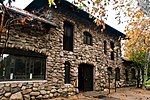Rancho Rosa Castilla
1831 establishments in Alta California19th century in Los AngelesAlhambra, CaliforniaCalifornia ranchosEl Sereno, Los Angeles ... and 7 more
History of Los AngelesLincoln Heights, Los AngelesMonterey Park, CaliforniaRanchos of Los Angeles County, CaliforniaSan Gabriel ValleySan Rafael HillsSouth Pasadena, California
Rancho Rosa Castilla was a 3,283-acre (13.29 km2) Mexican land grant in the southwestern San Rafael Hills, in present day Los Angeles County, California, given to Juan Ballesteros in 1831 by Governor Manuel Victoria.It included present day Rose Hills, Lincoln Heights, City Terrace, El Sereno and portions of South Pasadena, Alhambra, and Monterey Park. After California statehood, the land grant failed to receive confirmation from the U.S. Public Land Commission.
Excerpt from the Wikipedia article Rancho Rosa Castilla (License: CC BY-SA 3.0, Authors).Rancho Rosa Castilla
Montecito Drive, Los Angeles Montecito Heights
Geographical coordinates (GPS) Address Nearby Places Show on map
Geographical coordinates (GPS)
| Latitude | Longitude |
|---|---|
| N 34.09 ° | E -118.2 ° |
Address
Montecito Drive 809
90031 Los Angeles, Montecito Heights
California, United States
Open on Google Maps









